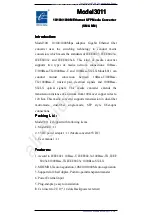
7
8
3.0 CONFIGURATION
Before placing the Model 2090 into service, the unit must be
configured to match both the DTE and T1 interface parameters.
Configuration is accomplished using pc board mounted DIP Switches.
3.1 CONFIGURATION USING DIP SWITCHES
Configure the Model 2090 using a DIP switch package located on
the bottom side of the printed circuit board (See Figure 1, below).
The Model 2090 DIP switches can be configured as either “On” or
“Off”. Figure 2 (below) shows the orientation of the DIP switches with
respect to ON/OFF positions.
Figure 1. Model 2090 Series bottom view, showing location of DIP switches
1
2
3
4
5
6
7
8
ON
OFF
ON
Figure 2. Close up of DIP switches showing ON/OFF positions.
DIP Switches SW1 & SW2
ON
OFF
1
2
3
4
5
6
7
8
ON
1
2
3
4
5
6
7
8
ON
SW2
SW1
3.1.1 DIP Switches SW1 and SW2
The configuration switches on the DIP switch pack will allow you to
specify data rates, line framing and coding, DSO rate, clock mode and
Line Build Out (LBO). Factory default settings of all switches are
shown in the table below.
* In unframed mode, SW2.2 is used with SW2.1 to determine the
clocking mode. In framed modes (ESF or D4) only network and internal
clocking are available. In unframed mode, where the DTE data rate is
1.544 Mbps, a third clocking option is available-external clocking, in
which the 2090 derives its transmit timing source from the DTE (See
Appendix D for external timing pin data).
SWITCH SETTING SUMMARY TABLE
1.536 Mbps
(DTE Rate)
Position
Function
Factory Default
Selected Option
SW1.8
Data Rate
On
SW1.7
Data Rate
On
SW1.6
Data Rate
Off
SW1.5 Data Rate
Off
SW1.4
Data Rate
Off
SW1.3
Starting Channel
Off
SW1.2
Starting Channel
Off
SW1.1
Starting Channel
Off
SW2.8
Starting Channel
Off
SW2.7
Starting Channel
Off
SW2.6
Line Build Out
Off
SW2.5
Line Build Out
Off
SW2.4
Line Code
Off
SW2.3
Frame
Off
SW2.2
DS0 Rate/Clock*
On
SW2.1
Clock
Off
Starting From
Channel 1
ESF
64 kbps
Network
B8ZS
0dB






























